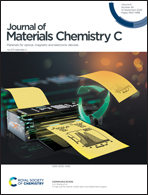Substrate mediated electronic and excitonic reconstruction in a MoS2 monolayer†
Abstract
The atom thickness of two-dimensional materials (2D) makes their physical and chemical properties vulnerable to external influences. In this study, we show that the electronic and optical properties of the MoS2 monolayer can be tuned by substrates (BN, g-GeC, and graphite). Based on first-principles calculations with the GW and GW plus Bethe–Salpeter equation (GW–BSE) approaches, we find that substrates provide effective dielectric screening to the electron–hole Coulomb interaction and result in reduced exciton binding energies in the MoS2 monolayer, which is more pronounced on graphite and GeC, due to more effective screening and stronger interfacial interaction, respectively. We further demonstrate that when the thickness of the substrate is increased, the exciton binding energy converges slowly due to the nonlocal nature of the screened Coulomb interaction, and encapsulating the MoS2 monolayer with the same substrate material further decreases the exciton binding energy due to increased screening. These results highlight the importance of substrate effects on the electronic and optical properties of a 2D semiconducting monolayer, and might offer an efficient way to tailor the performance of the relevant electronic and optoelectronic devices.



 Please wait while we load your content...
Please wait while we load your content...